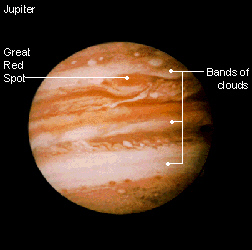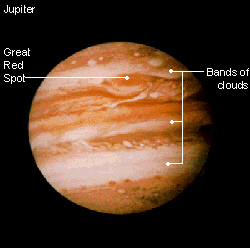|
|
|
JUPITER
Jupiter / Introduction
Jupiter is the giant of the Solar System. Seventy percent of the total mass
of the planets is accumulated in Jupiter. From the earth, we only see its
dense atmosphere, which is eight times thicker than the atmosphere of the
earth.
 Beneath
this atmosphere we find a layer of liquid hydrogen. The massive pressure
results in crystallization of the matter and the next layer closer to the
core of theplanet is made of metallic hydrogen.Jupiter has a rocky core with
a diameter of approximately 25,000 kilometers and very high temperatures
(30,000 to 35,000 °C). Beneath
this atmosphere we find a layer of liquid hydrogen. The massive pressure
results in crystallization of the matter and the next layer closer to the
core of theplanet is made of metallic hydrogen.Jupiter has a rocky core with
a diameter of approximately 25,000 kilometers and very high temperatures
(30,000 to 35,000 °C).
The temperature drops steadily towards the outer layers. In the upper cloud
layer, it is as low as minus 150 °C.Jupiter reflects 1.7 times the amount of
energy that it actually receives from the sun. The planet therefore produces
energy but has been inhibitedfrom developing into a sun. Despite its
enormous size, it simply lacks the mass for such an evolution. Jupiter is
not only the largest but also the fastest of all the planets of our system.
It completes a full rotation on its on axis in less than ten hours. This
high velocity has a great influence on the structure of its atmospheric
layers where bands of clouds appear, orbiting certain zones of the planet.
There are approximately ten different such zones on each of the hemispheres
of Jupiter (temperate, tropic and equatorial zones). These bands of cloud
blow with an enormous speed of up to 500 kilometers per hour in the
direction opposite to the planet’s rotation. They appear to be rather stable
and long-lasting structures as they have only marginally changed since the
first time they were observed about 50 years ago. The great rotation
velocity is ultimately responsible for the strong magnetic field of Jupiter,
which reaches as far as the orbit of Saturn. The atmosphere of the planet
consists mainly of hydrogen and helium with traces of other gases such as
methane and ammonia. One of the typical compounds found on Jupiter is
phosphine (PH3), which smells like garlic. Jupiter therefore keeps vampires
well away!
A particularly spectacular occurrence was observed in July of 1994. The
cometShoemaker-Ley 9 broke up into several fragments which then impacted on
Jupiter. These gigantic collisions caused huge explosions and their
brightness outshone the brightness of Jupiter by a factor of 50.
Orbit of Jupiter
Jupiter completes one full revolution around the sun in 11.86 earth years.
Its mean distance to the sun is 778 million kilometers and its orbit
velocity is approximately 13.05 kilometers per second.
 The
orbit velocity of the earth is just about 30 kilometersper second. The
orbit velocity of the earth is just about 30 kilometersper second.
Jupiter has a much greater rotational velocity than the earth (one complete
rotation equals one day) and is actuallythe fastest of all the planets. It
is accompanied by 16 satellites.
While the sidereal day of the earth is approximately 24 hours, it is only9
hours and 55 minutes on Jupiter. At certain times, it is therefore possible
to observe a full Jupiter day from the earth within one clear night. The
rotation axis of the giant planet is slightly inclined towards its orbit
plane(3.1 degrees) compared with the inclination of the earth’s axis of 23.4
degrees towards its orbit plane. As a result of the high rotational velocity,
the equators of Jupiter are slightly protruding.
Composition of Jupiter
Jupiter consists mainly of hydrogen. Its diameter at the equator is 143,000
kilometers. At its center there is a silicate core of approximately 25,000
kilometers in diameter and with an average temperature of 30,000 °C.
 This
core is covered in a layer ofionized hydrogen. This layer combined with the
high rotational velocity ofthe planet create the strong magnetic field of
Jupiter. This
core is covered in a layer ofionized hydrogen. This layer combined with the
high rotational velocity ofthe planet create the strong magnetic field of
Jupiter.
Between the layer of ionized hydrogen and the atmosphere thereis a thick
layer of liquid hydrogen.
The atmosphere itself consists of90% hydrogen and 10% helium with traces of
other compounds such as ammonia, methane and water.The dimensions of Jupiter
are gigantic and the earth could be stored 1300 times within Jupiter .A
further remarkable feature of Jupiter is the Great Red Spot, which is
actually at the heart of an anticyclone storm. There are numerous white oval
features to be observed on the planet that are also storm systems.
The Great Red Spot
The phenomenon of the Great Red Spot is visible on virtually all published
photographs of Jupiter. It is the largest and longest persisting storm in
the Solar System and described as an anticyclone.
 The
spot is suspended eightkilometers above the clouds covering Jupiter and its
diameteris three times that of the earth. The
spot is suspended eightkilometers above the clouds covering Jupiter and its
diameteris three times that of the earth.
The Great Red Spot was first observed more than 300 yearsago, although its
nature was at that time unknown. The many drawings and photographs that were
made of the phenomenon enable scientists today to establish that the spot
has only slightly changed in size over the last 300 years.The red color of
the spot appears to derive from phosphorus, which is produced when gases
reach the outer atmosphere and react under the influence of sunlight. The
Great Red Spot rotates about its own axis approximately 10 times a day and
moves at a very slow and irregular pace around the planet.
How is it possible that such an immense storm can persist for such a long
time? In contrast to the meteorological processes on the earth, new clouds
on Jupiter are formed instantly. Clouds on the earth are built up slowly by
the evaporation of water on the surface and it takes some time until the
water that rained down in the previous storm has evaporated to form new
”Rain“ on Jupiter falls into a hot atmosphere where the drops evaporate
instantly.
Jupiter Moons
Jupiter has a ring and sixteen moons. The four largest satellites are called
the Galileans after the name of the discoverer. They are Io, Europa,
Ganymede and Callisto.
 All
satellites are located outside Jupiter’s ring. Nearest to the ringare
Adrastea and Metis, followedby Amalthea and Thebe. Then follow the Galileans
and Leda, Himalia, Lysithea and Elara. All
satellites are located outside Jupiter’s ring. Nearest to the ringare
Adrastea and Metis, followedby Amalthea and Thebe. Then follow the Galileans
and Leda, Himalia, Lysithea and Elara.
The four satellites farthest from Jupiter are called Ananke, Carme,Pasiphae
and Sinope. These last fourmoons revolve around the planet in the opposite
direction to the other satellites and the rotation of Jupiter itself. It has
been suggested that they were originally planetoids , which were trappedby
the planet.They are up to 24 million kilometers distant from Jupiter. With
the exception of the Galileans that have dimensions comparable to the size
of our moon or even larger, the moons of Jupiter are rather small objects
with diameters of maximum 200 kilometers.
The Galileans are a particularly interesting group. Io has a distinct red
and yellowish color deriving from sulphur erupting from volcanoes. The
satellite is also heavily exposed to the magnetic field of Jupiter and
charged particles are exchanged between Io and Jupiter. Io features the most
active volcanoes in the Solar System. It has a diameter of 3640 kilometers
and its distance from Jupiter is approximately 422,000 kilometers.
Europa as well as Io are rather young moons. On February 20th, 1997, the
Galileo spacecraft took photographs of Europa that revealed most astonishing
facts. The satellite is partly covered by an ocean with icebergs floating on
it. The existence of liquid water other than on the earth had up to that
time been considered highly unlikely. That the satellite is a rather young
object was confirmed by the large number of meteor craters on Europa, which
has a diameter of 3140 kilometers and is approximately 671,000 kilometers
from Jupiter.
Ganymede is 1,070,000 kilometers from Jupiter and has a heavily cratered icy
crust.
© by
megasystems
|
|
|